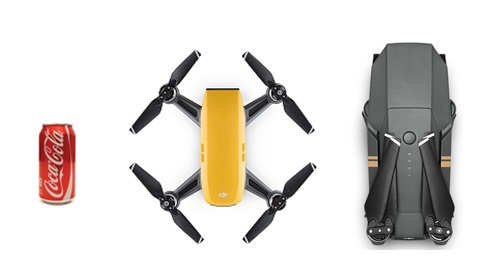Now that DJI has finally released the new DJI Spark camera drone, everyone who was sitting on the fence and thinking about buying a Mavic Pro has to make a decision.
DJI recently posted it’s own guide on how to chose between the Mavic and Spark camera drones (read it here) but we wanted to take it deeper for a more apples to apples comparison.
Making the best choice between the Mavic and the Spark comes down to a few important factors like video quality, hardware, flight time, size, video processing, and lastly how technical you are as a person.
But the differences in between the two drones can be deep depending on how involved you plan to be as an owner. So before we jog through the differences in the hardware, a good starting point is understanding you and want type of drone user you see yourself as. Are you a drone flyer or a drone pilot? Selfie king(or queen) or cinematographer? Facebook poster or Youtube editor?
- you literally want to fly your drone within minutes of receiving it, with little need for learning advanced features
- you want a drone with a pre-flight checklist you can count on one hand
- you want to enjoy a drone that has simple, built in intelligence, so you can enjoy QuickShots like Rocket, Dronie, Circle and Helix
- you want to just tap a screen to make the drone fly somewhere and film along the way
- you want the option to be able to take a quick photo of video without a smartphone or controller
- because you’re sharing to Youtube, Instagram and Facebook you don’t care that the video is only 1080p.
- you aren’t totally sure how deep you want to go with drone video and photograpy
- you understand that for a little more than half the price of a Mavic you can almost all of its awesomeness
- 15 minutes of flight time per battery isn’t an issue
- 1 mile of range is plenty with the optional remote control
- you want to fly without even using a phone or remote control
The DJI Mavic is the right drone for you if:
- you’re ‘juiced’ about having the most powerful, foldable, recreational drone on the market
- you want to jump all over the learning curve of Sport Mode, turning off downward sensors over water, and maximizing your understanding of all of the Mavic features
- you see yourself capturing dramatic places and events in 4K video at 30 fps as well as 2.7K and 1080p with choices of framerate
- you just understood what I said about framerate and it matters to you
- you will not be happy if you are not able to film in 4K
- you understand that learning to fly well requires time and effort to understand he more advanced hardware functions and features
- you would not be happy limited to a 1 mile range
- 15 minutes of battery life isn’t going to cut it
I hope these descriptors helped get you pointed more clearly towards the Mavic or the Spark. Now on to the hardware.
Camera Quality
The Mavic is a small yet powerful drone that turns the sky into your creative canvas. But the bottom line is all about the camera. The Mavic is equipped with a 4K Ultra HD camera that’s stabilized by a 3-axis mechanical gimbal. Video is supported at 30 frames per second.
The Mavic shoots still photos at 12-megapixels with Adobe DNG RAW support.
The DJI Spark shoots 1080p video, also at 30 frames per second, and like the Mavic, shoots 12-megapixel stills. In 1080p mode, the Mavic can shoot 30 or 60 frames per second, resulting in ultra-smooth video or great slower-motion movement at 60 fps.
Type A drone users shoot video frequently, not just on vacation or special occasions. He, or she, doesn’t mind dealing with big 4K video files that are difficult for the average computer to process and play. And this type of drone user isn’t afraid of jumping on a new learning curve to fully understand all of the features and controls packed into the Mavic.
The Type B drone user is looking for simplicity. They don’t want to buy a new computer just to be able to process and edit their drone footage (4K video files are roughly 4x larger in size than 1080p files). They want the simplicity of flying and sharing to stay in the palm of their hand, even if it’s not “ultra HD”.
The Type B drone pilot doesn’t have a 4K TV or laptop/monitor and isn’t planning on buying one any time soon.
The Type B drone user is mostly sharing video from their iPad or iPhone straight to Instagram, Facebook or Youtube using the features built into the DJI apps. Just like the Spark tagline “Seize The Moment” suggests, they want to share moments, not create epic movies.
And you can literally be flying the Spark, using it’s built in modes after just a couple of minutes of instruction.
Portability
Both the Mavic and the Spark are the ultimate in portability. When folded, the Mavic‘s footprint is barely larger than that of the Spark, and Mavic is roughly the same length as the Spark with propellers, even though it weighs about 3x more.

Flight Time
And whether you’re deciding to create movies or capture moments is going to be significantly impacted by flight time, which is determined by battery life.
The Mavic has up to 27 minutes of battery life. But you won’t get 27 minutes of flight time from it.
The Mavic starts and launces quickly. By the time you’ve powered up, calibrated and GPS’d your drone and are in the air hovering you’ll maybe be down a minute or two in battery life.
The Spark has about 15 minutes of battery life, about 55% of the Mavic‘s. It launches super fast from your palm, but it’s lighter and will struggle more with wind than the Mavic. With half of the Mavic‘s battery life, that leaves less flight time when you factor in how much needs to be kept for the return flight home.
Both the Spark and Mavic come with a 16GB microSD card, so you’ll be able to start filming and shooting right away. But here’s where the relationship between video resolution, battery life and flight time becomes complicated.
First, the 16GB microSD card is really only 14.8 GB due to the wonders of how they work.
Assuming you’re recording while in flight, at 1080p/30fps you will fill one GB of space for every 4 minutes of video. So if you’re actually filming 10 minutes out of every flight you’ll use up 2.5 GB of video space per battery.
At that rate, you’ll need almost six fully charged Spark batteries to fill the 16B microSD card. Sorry if that hurt your brain a bit, mine too.
The point I’m making here is that the Spark isn’t really designed for long flights and lots of video. It’s better for short clips that are shot in close proximity to the person controlling the drone.
The Mavic can do both. It has excellent range, up to 9km, and with the 27 minutes of battery life has potential recording sessions that are a multiple of what the Spark can do.
It all comes down to what you think you will do with your drone.
If you don’t know, then start with the Spark Fly More combo and learn the basics. Except for the built in information screen on the Mavic controller, the remotes are identical. With the Spark you can still connect your iOS or Android device and fly using the DJI GO 4 app. You’ll learn all of the same functions, controls and features as the Mavic.
When the time comes that decide you want to upgrade, you will be a much more skillful pilot out of the box as a result.
If you’re still struggling to decide, you are in good company. If I was trying to decide which drone to start with today I would be torn between the Spark‘s simplicity and ease of use and the full featured awesomeness of the Mavic.
The bottom line for me though, is this: if the Spark filmed in 4K I would absolutely start with it. Which is maybe why DJI opted to keep it 1080p. Maybe there will be some upgrades to the Spark in the future.
Whichever drone you buy, make sure you purchase the peace of mind and security that comes with DJI Care Refresh. Take our word for it. It is well worth it.
Related: What You Need to Know About DJI Care Refresh



